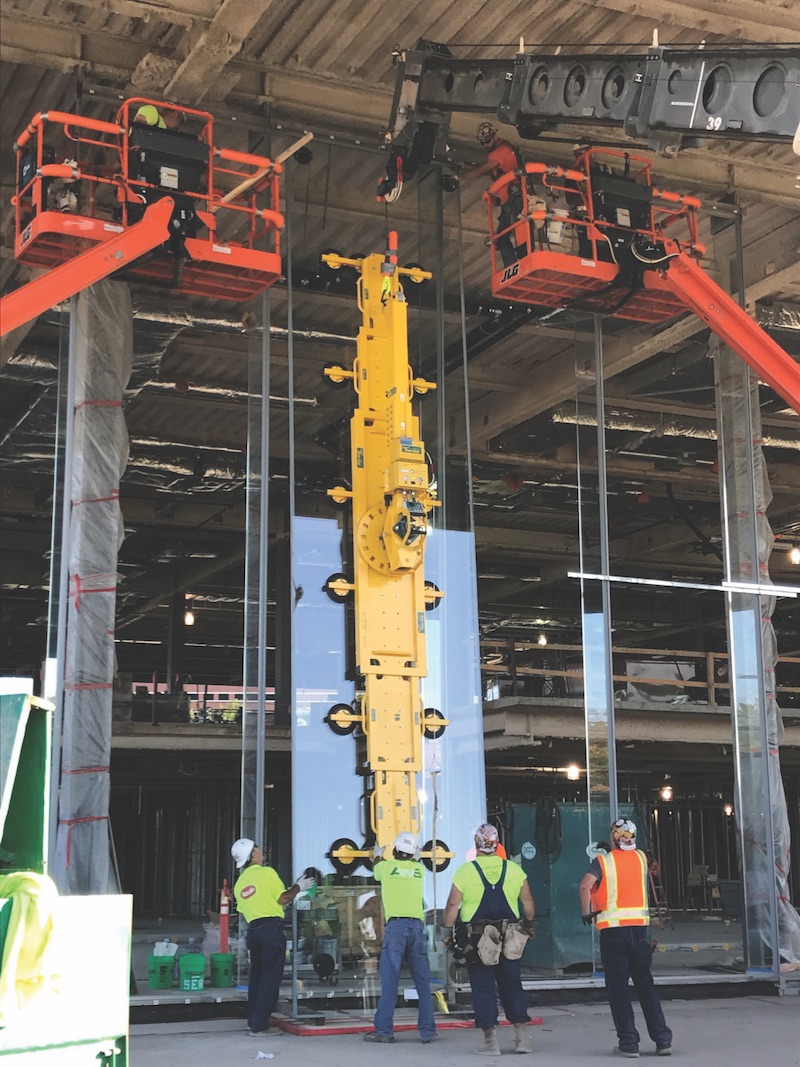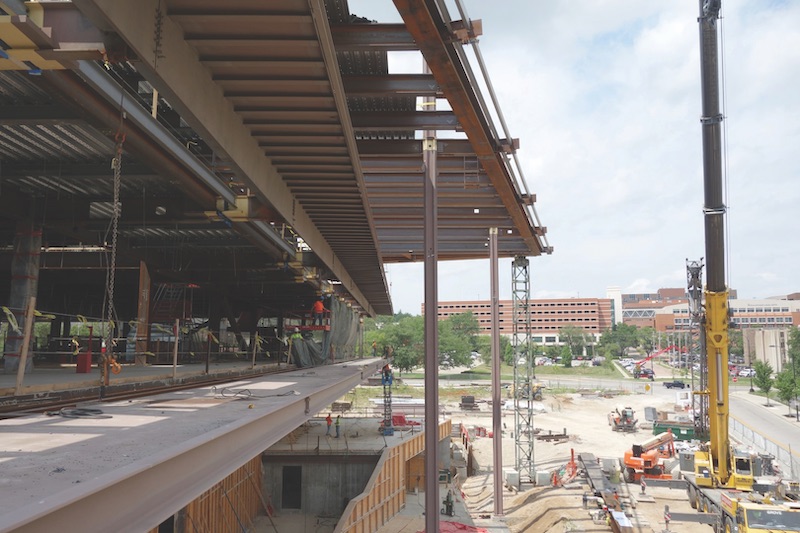The Krause Group is perhaps best known as the parent company of the convenience-store chain Kum & Go, which for nearly six decades has played an important role in the Midwestern communities it serves. That sense of community carries over to Krause’s beautiful new corporate headquarters, which is now part of the ongoing urban rebirth of Des Moines’s Western Gateway district.
The polygonal-shaped building, adjacent to two parks, is positioned by its owner and design team as a piece of art surrounded by an urban forest. The six-story building takes up only a quarter of the entire site; the rest is public space that includes 128 newly planted trees and shrubs and interactive landscape furniture.
Krause Gateway Center’s striking design takes its cue from the traditional French dessert mille feuille (“a thousand sheets”)—razor-thin layers of puff pastry interspersed with a buttery cream filling.
The goal was to make the 100-foot-tall building’s horizontal planes appear to be “flying” over the site. Krause Gateway Center sits precisely where two orientations of the city grid intersect: its upper floors orient to the northern city grid and align elegantly with lower floors that orient to the southern city grid.
 Twenty-nine-foot-tall glass panes weighing 4,000 pounds each were installed for the entrance by cranes and a special suction-cup apparatus, both of which had to negotiate minimal overhead clearance.
Twenty-nine-foot-tall glass panes weighing 4,000 pounds each were installed for the entrance by cranes and a special suction-cup apparatus, both of which had to negotiate minimal overhead clearance.
The façade, which is 85% glass, helps accentuate this metaphor. The façade extends to the lobby atrium with 29 laminated glass panels, each 29 feet tall and weighing 4,000 pounds. That weight required the project team to develop a special suction-cup system for positioning the panes into place.
The 10-foot-wide, 9-foot-tall glass panes surrounding the building’s 12-foot-tall offices provide occupants with unobstructed 360-degree views.
The building required a higher degree of precision than most new office buildings do, right down to the details in the construction documents and the project’s schedule management. (Oracle’s Primavera P6 software was used to provide analysis and reporting.) The architects demanded tolerance levels as tight as 1/32nd of an inch. The design also minimized the floor-to-floor heights of each level, so 90% of the MEPF system had to be routed through 1,400 penetrations into structural steel.
Ironically, a building with such an appearance of lightness has a structure that required 50 lb/sf of steel. The longest beam is 89.5 feet and weighs 25,243 pounds; the largest girder, at 62,500 pounds, needed two cranes to be hoisted into place. Two supercolumns, 65 feet in length and custom-fabricated out of 2.5-inch-thick steel plates, support the entire east side of the building’s fifth floor. Steel-plated cantilever overhangs on each floor protect interior spaces from direct solar radiation.
Planning and coordination contributed mightily to the success of this three-year project, for which more than 1,000 tradespeople and 90 designers and subcontractors were involved. This started with members of the Building Team leading Krause Group execs through visioning and goal-setting exercises. A stakeholder steering committee engaged the building’s neighbors, city officials, and business leaders to identify potential development opportunities. As the project kicked into gear, early foundation packages allowed construction to move forward before the structural design was complete.
 The entire 5th floor of the building’s east side is supported by just two super columns. The columns were fabricated out of 2.5-inch-thick steel plates, and extend up to 65 feet.
The entire 5th floor of the building’s east side is supported by just two super columns. The columns were fabricated out of 2.5-inch-thick steel plates, and extend up to 65 feet.
Full-scale mockups of everything from window systems to restroom stalls were seminal to the project’s successful completion.The project team spent the better part of a year producing mockups of concrete walls and hardscapes. Determining what level of quality the walls would need even included a site visit to Athens, Greece. (The Building Team finally decided that it could achieve the desired quality level by rubbing and patching the concrete after the forms were removed.)
The finished building has an art space, multifunctional meeting rooms, a fitness center, a large exterior terrace, and a rooftop plaza that features native grasses, a glass-enclosed pavilion, and 2.8 million pounds of pavers. The plaza can accommodate parties up to 900 people.
Planted on the roof is a 100-foot fiberglass mast that symbolizes the connection between the headquarters and the company’s stores across the country.+
Building Team — Submitting firm Ryan Companies (GC), Owner/developer Krause Holdings, Architect Renzo Piano Building Workshop, AOR OPN Architects, SE Silman, ME Waldinger Corporation, EE/PE Baker Electric
General information — Size 163,307 sf, Cost $151 million, Construction time January 2015 to November 2018, Delivery method CM as Constructor








